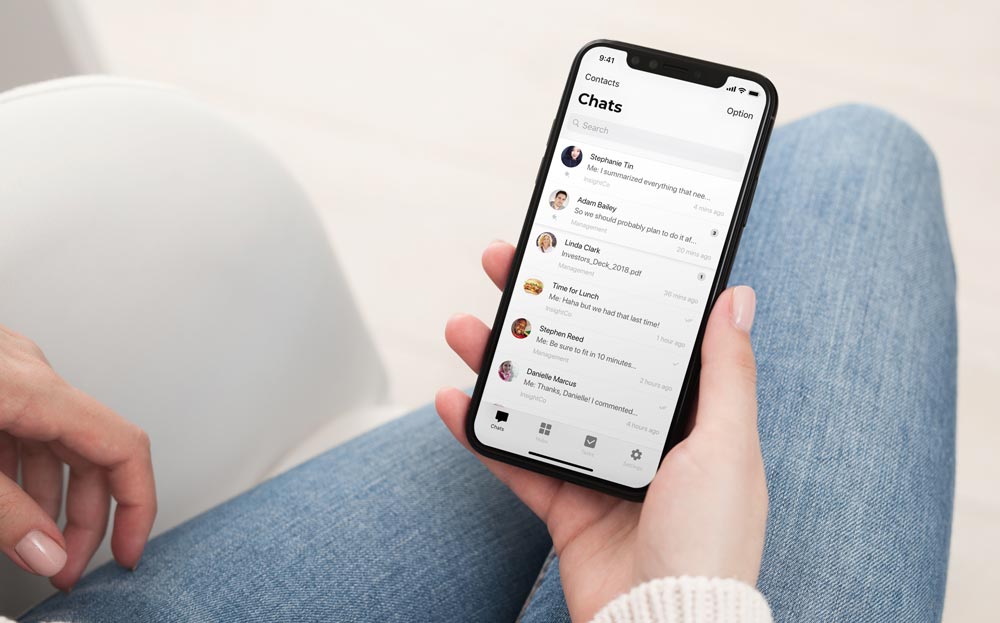Ah, group chat, the fuel of the modern day workplace.
It offers the convenience of having all your communication in one place, instantly searchable, and available on the go. But with this digital shift, comes unspoken etiquette, and a level of respect and responsibility that can easily get lost in the chatter – not to mention some embarrassing moments! How can you get your message across without feeling like you’re drowning in the group? Are you using the right tone? Is this an appropriate thing to say in a business chat?
Keeping all this in mind, entrepreneurs and leaders like you lay the ground rules for how your teams can effectively use chat tools to nurture a culture of productivity. Here at Brief, a productivity and communication tool, we aim to make a more focused, collaborative group chat app for leaders and teams. Our Hubs keeps your team going with clutter-free, minimalistic design that ensures you stay on track to get your important tasks done.
In this post, our aim is to help you establish a more collaborative and engaged culture by sharing 8 suggestions you can implement to get the most out of Brief’s chat tool.
1. Remember, it’s not email
In an email, you have time to compose the full extent of your thoughts and then send the whole message all at once. Chat is different; it’s a dynamic conversation. If you’re starting the conversation, then it’s a great way to get all the points across at once. But once you’re in the middle of a chat, instead of composing three long paragraphs and leave the person on the other end guessing if you’re even there, share shorter, concise thoughts. Keep the conversation flowing as though it were face-to-face. Allow room for input as you go.
With Brief, you have the added benefit of also editing your message once it has been sent. So if for some reason you typed too quickly or didn’t spell check before you hit send, and you notice a fatal flaw in your message, you have the ability to hit ‘Edit’ and correct the message – even after you have already sent it to the other person or group.
Instant messaging is synchronous where messages can flow in all directions, to and from multiple participants, enabling a real-time discourse. That’s what makes an instant messaging tool like Brief so effective in the workplace. It ensures work can continue in a prompt, collaborative and productive manner. Team members can check in quickly and spontaneously to get work done. The important thing is to have your thoughts and points clearly laid out in your mind before you start hitting that keyboard. This way, you can have more focused and productive conversations in real time.
2. Acknowledge receipt of a message
If a team member, client or manager has asked you to work on a project and you’ve seen their request, let them know. Again, instant messaging is not email. You can’t flag it as important and get back to it later. The key here is “instant” communication, not “later” communication. Even if you can’t work on their request right away, that’s totally fine. Just let them know that you’ve seen it and will tackle it at an allocated time slot. Tools like Brief let you see when another user has read your message – this ensures conversations operate in a more fluid, transparent manner. However, it also makes it all the more important to get back to others out of courtesy. A simple: “Hey Jim, I can get started on this task today at 3 pm. Will revert back to you at around 4, sounds good?” will do.
This transparency and clarity are what keeps team productivity flowing. Everyone can stay on the same page and they know what the other person is working on. This way expectations (deadlines, ownership and delivery) are set and you will get the best out of the people in the group. With Brief, you can easily take a chat message, convert it into a task and boom, you’ve got a reminder of what’s next on your plate. Stay focused, stay on task and get your work done effectively. Save time by grouping all your similar tasks together, knock them out of the park at once, and have time left over for that round of golf you planned with your friend.
3. Respect deep work, for yourself and others
“My success, part of it certainly, is that I have focused in on a few things.” – Bill Gates
To produce work at your very best performance level – you need to cut out distractions, quit multitasking and concentrate for an extended period on a single task. Focus is becoming a much-needed skill for the future workplace.
So with chat, everyone is easily accessible at any time. But try not to take this for granted. We recommend that when you start a conversation with a team member, indicate to them whether you need an immediate response or whether they can get back to you when they have time. Show that you value and respect their time and don’t need them to be immediately responsive at the expense of focus and thoughtfulness.
In the same way, let your team know if you’re going to be unreachable for a few hours. If you don’t want to be disturbed with notifications, simply ask only to be reached if it’s something urgent. You’re all on the same team with the same goals, so going off the grid for a bit will only advance the collective goal. One person’s win is the whole team’s victory. Don’t feel bad about tuning out of conversations – Brief lets you mute notifications for all or some conversations, so you can stay focused on the task at hand.
4. Check, check and check again
So many blunders happen daily in instant messaging tools, leaving people screeching out “oh no!”. Then there is also the old “Oops, I posted it in the wrong chat/group” blunder.
Before you click send take that extra second to check that you’re in the right window and are about to send it to the right person. The most common reason we make this mistake is that we’re chatting with multiple people at the same time, and flicking off multiple messages at a super fast speed.
Take this manager who’s had an awkward encounter with his colleague:
“A woman I was training at work sent me by mistake an “I love you, [her husband’s name].” Absentmindedly, I thought it was a message from my wife, who I was also messaging at the time. Absentmindedly, I answered, ‘I love you too.’
That became an interesting and awkward next workday.”
Another coworker shares her oopsie moment:
“I chatted to what I thought was a friend that I had a huge crush on a coworker, Jasper, but accidentally sent the message to Jasper.”
So again, a little valuable reminder to double check your window before hitting that send button. With Brief, our ‘Edit’ and ‘Delete’ feature allows you to backtrack if the sender has not read the message before your backtrack takes place. We’ve taken care of that feature, the only thing you need to do is be quick about it!
5. Scope out the scene
The same way you may tend to play it cool at a party with new faces, take your time to see what’s the norm in the group chat. First read what’s being said by the other members. What tone do they use? Do they use emojis? Is it strictly professional, or do they share personal stories? All this will help you to get a clear sense of what is acceptable in a particular group. Be mindful of who else is in the group chat. Is your boss there? Is your CEO in the group? Are there any clients, perhaps?
Be sure to keep the content relevant to the group. This is easier to do when the name of the group chat clearly indicates the subject. A group named “Marketing Campaign Ideas” is much easier to keep focused on-topic than a massive group chat called “Marketing.” Nobody likes it when two people in the group have a lengthy conversation that doesn’t concern anyone else.
Show that your value the group’s time by offering valuable and applicable content, and take private conversations 1-on-1. In group chat, a good rule of thumb is to keep it Brief (pun intended). Keep your messages short, clear and relevant to the decision at hand. Nobody likes it when people go on and on about an issue that was addressed earlier in the conversation, so make sure that if you do have to that, you communicate clearly exactly why this is worth the group’s collective attention.
6. Formatting etiquette in chats
Since instant messaging is quick and more informal compared to email, it doesn’t mean they require less thoughtfulness. Grammar and formatting in chats can often make the difference between you being taken seriously or getting little to no valuable responses to your messages. Consider things like the use of caps and Emojis. Caps are never a good thing in chats as they denote ‘shouting’. Emojis are great, but use them sparingly and most times, not with senior people unless you are engaged in more of a one-to-one conversation with them where it might be more appropriate.
7. Take note of conversation context
Group chat apps like Brief have the option to reply or forward specific messages – make sure to use it! It’s much easier for another chat participant to navigate a long conversation if everyone takes the time to reply to individual messages in a structured way that provides context to any questions, comments or ideas.
In general, don’t let the pace of the conversation get the better of you. Before asking “what?” or “I missed that” in a group chat, take the time to scroll back up and read the messages in context. Your answer might already get answered this way, if not, at least now you know what’s going on and can give a more relevant response. No one likes it when a person doesn’t keep up and then pops up later, when the conversation has already ended. If you are late to a conversation, don’t just randomly reply to the end of the message trail. Rather, go back, hit reply to the message you want to refer to and make it clear to all that your reply is in context to an earlier thought.
Also, consider the cultural context. If you have many remote teams in different geographical locations, be mindful of what may get lost in translation. Avoid using culture-specific slang, for example; “sorry, I have to bail on this task” since bail has a double meaning and a native non-English speaker might understand it literally. Speak clearly and concisely, taking care not to confuse or potentially offend another culture.
Lastly, realize the limitations of chat. When a concept is hard to explain, an issue is getting complex or a discussion isn’t reaching a resolution, schedule a quick video or audio Brief call and switch communications channels to get the matter sorted out directly with that person or group. Brief’s high quality video calls let you have valuable face-to-face time even if your team is dispersed between Barcelona, New Mexico, and Toronto. A quick video call can clear up any miscommunication in seconds.
8. Create a space for fun
Group chat is a great way to collaborate effectively and run a business smoothly. But it’s also a fantastic way for teams to bond, strengthen your company culture and have the occasional harmless fun. When your team is crunching ahead of a tight deadline, or when professional decision making takes a toll on morale, a funny meme or friendly banter can do wonders to improve everyone’s mood.
A great way for your team to bond is to create a dedicated group chat for the more light-hearted and funny conversations, sharing interesting links and articles, making lunch plans and other non-work related topics. Having a non-work related chat space like ‘Social’ or ‘General chat’ can make it easy to tune in and out of the banter, and then to dip into it when you have the headspace to do so.
With Brief, you can change the notification settings on individual group chats to avoid getting distracted. Set your work chats to alert you, and the social ones to ‘non-alert’ so you can go into them when you have time, and not be distracted with all the chatter notifications popping up on your screen. Team bonding and humor can really make a company feel like a family – but be sure to watch out that the digital water cooler chat doesn’t overwhelm your team and become unproductive mindless chatter.
All in all…
Brief is a great tool for focused work and thoughts to flow. You must, however, be disciplined in how you use it and understand the etiquette for effective chat communication within the workplace. The lines between work and professional life are becoming increasingly blurred as we’re more connected than ever. But remember, work chat is different and it needs to be treated differently. There’s a time and place for everything.
These eight guidelines can be the building blocks for effective communication and harmonious coexistence with your team members and clients. Just like your business isn’t static, treat instant messaging in the same agile manner. Consistently identify ways to improve communication with your team and maintain an organized and focused set of group chats. Lead by example and embody the change you wish to see.
Happy messaging!
Deeper focus and effective communications are just a click away. Join Brief for free and invite your team in seconds.






